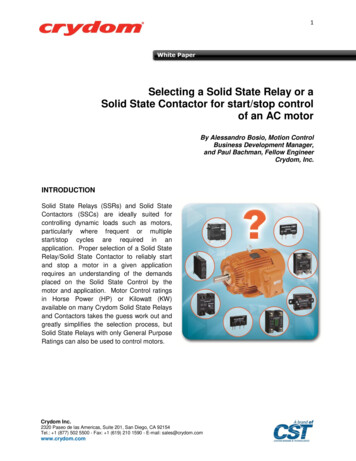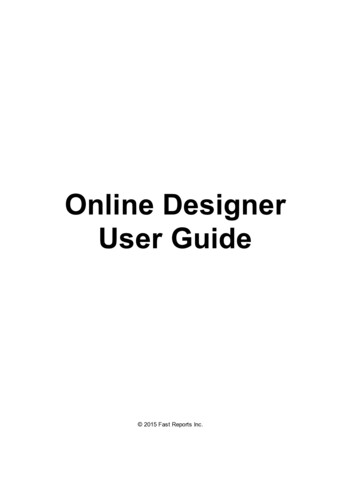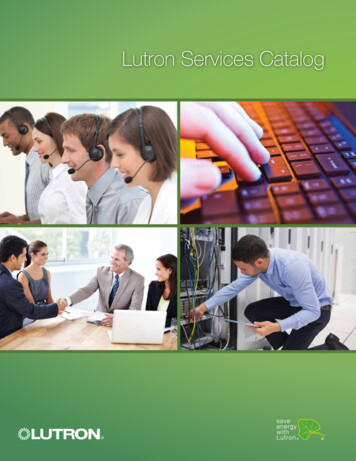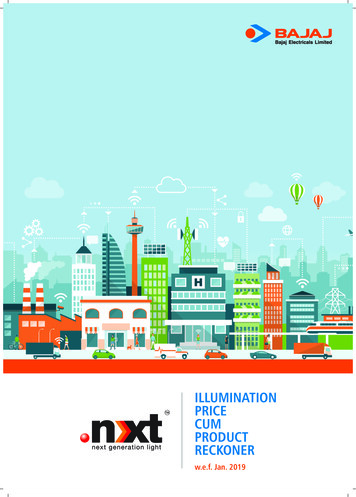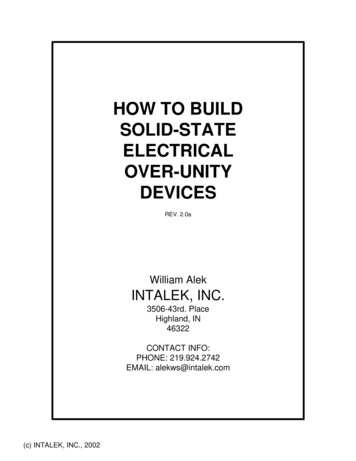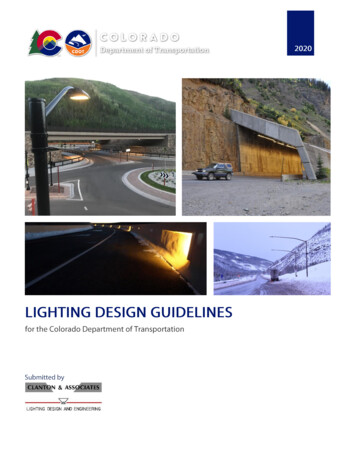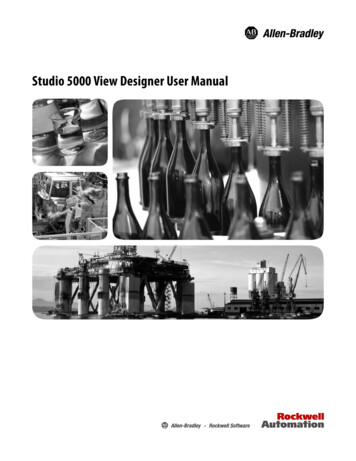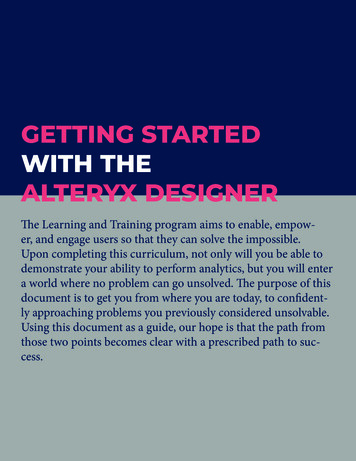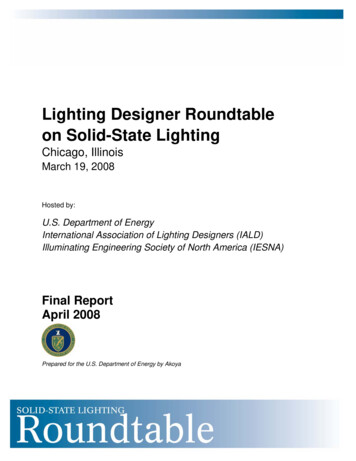
Transcription
Lighting Designer Roundtableon Solid-State LightingChicago, IllinoisMarch 19, 2008Hosted by:U.S. Department of EnergyInternational Association of Lighting Designers (IALD)Illuminating Engineering Society of North America (IESNA)Final ReportApril 2008Prepared for the U.S. Department of Energy by Akoya
DISCLAIMERThis report was prepared as an account of work sponsored by an agency of the United StatesGovernment. Neither the United States Government, nor any agency thereof, nor any of theiremployees, nor any of their contractors, subcontractors, or their employees, makes any warranty,express or implied, or assumes any legal liability or responsibility for the accuracy,completeness, or usefulness of any information, apparatus, product, or process disclosed, orrepresents that its use would not infringe privately owned rights. Reference herein to any specificcommercial product, process, or service by trade name, trademark, manufacturer, or otherwise,does not necessarily constitute or imply its endorsement, recommendation, or favoring by theUnited States Government or any agency contractor or subcontractor thereof. The views andopinions of authors expressed herein do not necessarily state or reflect those of the United SatesGovernment or any agency thereof.COPIES OF THIS REPORTElectronic (PDF) copies of this report are available to the public from:U.S. Department of EnergyOffice of Energy Efficiency and Renewable EnergyBuilding Technologies ProgramSolid-State Lighting Research and Development Portfoliohttp://www.netl.doe.gov/ssl1
ACKNOWLEDGEMENTSThe U.S. Department of Energy would like to acknowledge and thank all the Roundtableparticipants (listed in Appendix A) and their companies for their active engagement in this effort.This constructive and informative event would not have been possible without the contributionsof all and especially those of the following direct contributors:Katherine C. Abernathy, Abernathy Lighting DesignNicholas J. Bailey, International Association of Lighting DesignersDerry Berrigan, Derry Berrigan Lighting DesignKevin Dowling, Philips Solid-State Lighting SolutionsRita Harrold, Illuminating Engineering Society of North AmericaSamantha LaFleur, AtelierTenJeffrey Miller, Pivotal Lighting DesignEric Richman, Pacific Northwest National LaboratoryMarsha Turner, International Association of Lighting DesignersCOMMENTSThe Department of Energy is interested in feedback or comments on the materials presented inthis Workshop Report. Please write directly to James Brodrick, Lighting R&D Manager:James R. Brodrick, Ph.D.Lighting R&D ManagerEE-2J/Forrestal BuildingU.S. Department of Energy1000 Independence Avenue SWWashington, DC 20585-0121CONTENTSIntroductionSummary of PresentationsRoundtable Discussion with Meeting ParticipantsSession Wrap-Up33710AppendicesA List of ParticipantsB Draft DOE/IES Design Guide: Lighting Design with LEDsC Stokes Shift2
IntroductionOn March 19, 2008, the U. S. Department of Energy, along with the International Association ofLighting Designers (IALD) and the Illuminating Engineering Society of North America(IESNA), hosted an invited group of lighting designers for a Roundtable meeting in Chicago.The focus of the one-day gathering was to examine solid-state lighting (SSL) market andtechnology issues and to encourage a discussion of the designers’ experiences, ideas, andrecommendations regarding SSL and the SSL industry.Sixteen lighting designers attended the one-day meeting, along with representatives from DOE.DOE’s James Brodrick welcomed the Roundtable participants, emphasizing that the lightingdesign community is a critical part of the complex process of getting SSL into the marketplace.He noted DOE’s intention to share designer feedback from this meeting with researchers,manufacturers, and product designers.Brodrick stated that the transition to SSL requires industry-wide solutions, calling forunprecedented coordination, collaboration, and information exchange among government,industry, manufacturers, standards groups, designers, specifiers, and end-users. With designers’input, DOE can better address technical issues and improvements in SSL products though itsR&D program, as well as strengthen its work with industry to assure higher product quality,develop informational materials, and support effective educational programs.To set the context for the day, several presentations were given at the outset to providebackground information and material for reflection. These presentations are summarized below.The heart of the day involved interactive discussion about what needs to be done to achieveviable products and widespread applications for SSL technology. Highlights of the Roundtablediscussion and breakout sessions are summarized later in this document, with a synopsis of theissues identified and recommendations discussed.Summary of PresentationsIALD — The Designer’s Vision for SSLJeffrey Miller, IALD board president, thanked DOE and acknowledged the presence of some ofthe best lighting designers in the world and a number of past and present IALD board members.Miller observed that nothing seems to ignite the industry right now like SSL, adding that clientsare telling designers they want to use LEDs, but much is still not known about lifetime and otherperformance variables. He cautioned against a single platform or “Windows”-type dominance,noting that multiple viable SSL platforms would broaden design and financial choices.Miller also encouraged development of industry standards that make sense. “CALiPER has beendoing a great job in testing light fixtures to see if they meet manufacturers’ claims,” he stated.He urged IESNA and the American National Standards Institute (ANSI) to establish benchmarksthat designers can use for comparisons. Finally, he recommended that DOE convene similarmeetings more frequently, because designers want to be involved and provided withopportunities to share knowledge and understanding – whether with manufacturers, standardssetting groups, or demonstration projects.3
IESNA — Solid-State Lighting from an Engineering PerspectiveKevin Dowling chose a quote, “The system is the product,” to set the tone for his take on SSLfrom an engineer’s point of view. Dowling, who serves as chair of the IESNA sub-committee onsolid-state lighting, cited astounding growth throughout the SSL industry, includingbreakthrough developments in such areas as lumens per watt, color rendering index (CRI), andcolor quality, all happening much faster than most in the industry anticipated.Although many manufacturers produce LED fixtures, designers who specify products – andconsumers themselves – must be cautious, Dowling advised. New standards are needed, and aregradually coming into place, with the recent release of C78.377-2008 and the imminent releaseof LM-79 (editor’s note: LM-79 has been released since the Roundtable was held) and LM-80 asthe first tangible results of an accelerated, collaborative standards development process. 1Following a quick overview of some product development aspects of SSL, Dowling observedthat manufacturers are looking for the best application-package mix, but a “higher horsepower”attitude is not always the right answer. With SSL, the whole package needs to be re-thought.“Currents drive costs,” Dowling stated, adding that price is still an issue, especially initial costs,but the industry is making headway, particularly through improvements in product life.Overview of DOE Market Introduction Activities for Solid-State LightingJames Brodrick next offered a look at the Department of Energy’s SSL-related market2introduction activities. He briefly reviewed the “pathways to market” supported by DOE, including testing, demonstrations, design competitions, ENERGY STAR -related efforts,technical support for standards, and technical information channels.DOE’s CALiPER Program supports testing of commercially available SSL products for the3general illumination market. The first four rounds of CALiPER testing are now complete, andresults will provide unbiased product performance information, guiding DOE planning for R&D,GATEWAY Demonstration, and ENERGY STAR initiatives, and informing the development ofindustry standards and test procedures. Test results also serve to discourage low qualityproducts, helping to reduce the risk of buyer dissatisfaction from products that do not perform asclaimed.4The intent of DOE’s SSL Technology Demonstration GATEWAY Program Brodrick explained,is to provide a source of independent, third-party data for use in decision-making by lightingusers and professionals. Each GATEWAY Demonstration compares one SSL product againstthe incumbent technology used in an in-the-field application. Through the Roundtable and futureinteraction, DOE hopes to encourage more lighting designer involvement in demonstration1234For more information on SSL standards, visit: tandards.htm.For DOE’s fact sheet, Guiding Market Introduction of High Efficiency, High Performance SSL Products, go to:www.netl.doe.gov/ssl/PDFs/Materials 2008/CommSupp 08FS.pdf.For CALiPER summary analyses and detailed test reports, visit www.netl.doe.gov/ssl/comm testing.htm.For more information on DOE SSL GATEWAY demonstrations, visit: www.netl.doe.gov/ssl/techdemos.htm.4
opportunities. Noting the need for qualitative analyses in GATEWAY demonstrations, Brodricksought the involvement of IALD and designers in more strongly addressing this aspect.5National design competitions such as Lighting for Tomorrow encourage and promote energyefficient lighting fixture design. Sponsored by DOE, the American Lighting Association, and theConsortium for Energy Efficiency, Lighting for Tomorrow recognizes well-designed, energyefficient residential LED fixtures. In addition, Brodrick previewed the May 2008 launch of the“Next Generation Luminaires” competition, which seeks to recognize and promote commercial6LED luminaires.Another competition that will further heighten awareness of high-performance solid-statelighting products is the “Bright Tomorrow Lighting Prizes” competition. Section 655 of theEnergy Independence and Security Act of 2007 includes provisions for significant prizes for newlighting technologies that can serve as replacements for inefficient lighting products thatdominate the market today. The legislation challenges industry to develop a 60W incandescentreplacement lamp, a PAR-38 halogen replacement lamp, and a 21st Century Lamp.The development of ENERGY STAR criteria for SSL products will accelerate marketpenetration of better performing, higher efficiency products. Criteria were announced in7September 2007, with labeled products expected to be available in October 2008. DOE alsosupports the development of standards and test procedures, and keeps industry and consumers89informed through the DOE SSL web site, regular SSL Updates, SSL technology fact sheets, the10SSL Technical Information Network (TINSSL), planned market studies and technicalevaluation reports, and annual R&D and Market Introduction workshops.In closing, Brodrick invited the designers to attend the upcoming Voices for SSL EfficiencyMarket Introduction Workshop. Sponsored by DOE, the Northwest Energy Efficiency Alliance,the Energy Trust of Oregon, and Puget Sound Energy, the workshop will be held in Portland,11Oregon, in July 2008.Overview of DOE/IES Design Guide for Solid-State LightingSamantha LaFleur, a lighting designer with AtelierTen in Baltimore, Maryland, joined EricRichman of Pacific Northwest National Laboratory to update participants on the status of theDOE/IES Design Guide: Lighting Design with LEDs. Prior to the Roundtable, a draft of theGuide (see Appendix B) was distributed to participants for review in preparation for the session.The purpose of the Guide is to focus on achievable, marketable products, to create a commonvocabulary for specifiers and manufacturers, educate potential users about the possibilities andchallenges of SSL, raise good questions for better results, and drive the market to improve567891011For more information on Lighting for Tomorrow, visit www.lightingfortomorrow.com.Information on the “Next Generation Luminaires” competition will be available soon at www.netl.doe.gov/ssl.For more information on ENERGY STAR, visit www.netl.doe.gov/ssl/energy star.html.To visit the DOE SSL web site, or to register to receive the SSL Update, go to www.netl.doe.gov/ssl.To view the SSL technology fact sheet series, visit sheets.htm.For more information on TINSSL, visit www.netl.doe.gov/ssl/technetwork.htm.More information on the Portland Market Introduction Workshop will be available soon at www.netl.doe.gov/ssl.5
luminaires. The Guide’s intended audience includes contractors, specifiers, architects, salesrepresentatives, and those involved in product development.The Guide features technical information on performance, special characteristics of LEDs, andapplication challenges, as well as design guidance on specific applications according to spaceand building types. It examines LED performance in terms of absolute versus relativephotometry, performance standards, light output, color quality, correlated color temperature(CCT) and CRI, and color compatibility, in addition to looking at thermal management, productlife, and energy efficiency.“Why LEDs?” was the question LaFleurkept central during her involvement inpreparing the Guide. “If we can make thisa document that solves some of our issues,starts a dialogue, and gets some of thisinformation out, we’ll be closer to generalmarket comfort and clarity. One of ourgoals today is to walk you through and getfeedback about how ‘on track’ we are, andwhat is missing.”LaFleur spoke of designers’ concerns –such as “specify-ability” – before aproject, in the design and specificationSamantha LaFleur discusses the Design Guide for Solidstages, during construction, and afterState Lighting with Roundtable participants.installation. “What happens when thesystem fails? We are basically buying acompany more than a product, and manufacturers do not always follow through. This increasesdesigners’ risks exponentially in choosing to specify SSL products.”Feedback from participants included requests to add space types such as theaters, arenas, andhealthcare facilities, to talk about quality of light in the “task” section of the Guide, and toaddress such concerns as “the biggest issue” of liability. Another participant noted theimportance of spectral power distribution, pointing out that LEDs are an interrupted spectrum oflight. Most current white LEDs are phosphor-converted, which can impact the efficiency of theLED product by changing the spectrum of the original LED diode. Kevin Dowling illustratedthis concept in a diagram showing “Stokes shift,” which is included in Appendix C.In summary, both Richman and LaFleur again encouraged participants to review the Guide, andprovide their feedback on issues and concerns, as well as their suggestions for improvement.“Our business is very much about managing risk,” LaFleur observed, “and my hope is that toolslike this Guide can support our work and help us manage these risks.” Suggestions and feedbackfrom participants will be incorporated into the final draft version of the Guide, to be forwarded toIESNA by June of 2008.6
Roundtable Discussion with Meeting ParticipantsSamantha LaFleur and Derry Berrigan, ofDerry Berrigan Lighting Design inRogers, Arkansas, introduced theRoundtable session, drawing on theirpersonal experiences to set the stage forthe frank and lively discussion thatfollowed. The session was designed toelicit participants’ perspectives on theirsuccesses, failures, considerations, andneeds in incorporating SSL into lightingdesigns. Participants were asked toanalyze their key concerns, focusingon “What’s Going Right” and“What’s Not Going Right” in theareas of design, implementation, andperformance of SSL.Comments are summarized in thetables below.Breakout sessions focusedon identifying key actionsand next steps forgovernment and industry.Lighting Designer Roundtable FeedbackSSL – What’s Going Right Small format allows luminaire design and architectural design flexibilityLow expected connected loadEfficiency above similar sourcesColor changing ability – LED systems can be tuned for lighting mood effectsLow heat (front) – Little heat is radiated towards occupants and objects providingmore comfortNo UV – ideal source for fragile artifactsLong lamp life allowing reduced maintenanceVibration resistance due to no filament and compact formatCold temperature operation without the issues with FL technologyDirect low-voltage input good for some renewable systems and design flexibilityCan easily daisy-chain fixtures with low voltage connectors7
Lighting Designer Roundtable FeedbackSSL – What’s Not Going Right: Issues and ConcernsOverall Lack of definition of SSL as tool – is it a lamp or a system?Technology Rapid pace of technology changes Immediate performance vs. down the road Information flowManufacturing/Products Cycle – 2 yearso 1) Design 2) Spec 3) Installo Product might not be around in 2 years Truth in advertising is not there: “lasts forever” More standardized cut sheets (templates)o Among LEDso Among Hg products Model specificationso Like nutritional guide – standardized form Published data must follow some government standard Maintenance contract issues Potential availability of matching replacement parts “Box on a shelf” vs. separate parts Lack of modularity Want to be able to compare things in my tool box Easier if fitting into current modelo Universal LED socket design could accommodate issues Lack of info on product details LED uplightso Shift to greeno Back to factory to look atCost issues Volume of sales not yet high enough to bring down costs Hard to track true price of SSL Perception of low cost may not reflect complete luminaire costsDistribution system – potential for new way to sell and market Start with government contracts? Put new products out as direct sales? Recommend to owners to buy direct Government role to support direct salesGovernment Seed money for industry collaborative effort for standards8
Breakout Discussion – Small GroupsThe final component of the Roundtable session was a breakout into three discussion groups, toidentify key actions and needed next steps. Summarized here are the findings of the three groups.Breakout Group One – Priorities for Action1. Accepted standards – need to have standards in place that are acceptable to industry and thatprovide useful comparative metrics for users.2. LED replacement availability for LED luminaires – the market will lean in part towardavailability of actual replacement LED packages. This idea of “lamp” replacement will beimportant to address.3. Cradle-to-grave footprint, compared to other sources – very important to develop and getRIGHT as green is in. But very important to also do for other competing technologies –NOT JUST LED!4. Color shift over time – not enough seen on this issue and it may become important. Theindustry needs to feel comfortable that they know what this is, as they do for othertechnologies.5. Claims! – misinformed claims are everywhere andd need to be counteracted where possible inpublic arenas. Programs like CALiPER are good but this does not reach the public.6. Market distribution – industry is interested in a better way to distribute products and thereare concerns with compatibility between products that are unlikely to be helped with currentsystems.7. Cost – Too high and only slows market down in the beginning. Need ways to connect massapplication opportunities to help reduce costs.8. Power hook-up standardization – potential issue with various connection options DC, AC.Breakout Group Two – Priorities for Action1. Risk Failures – need simple solutions for performance failures and replacement UL requirements2. Cost No system for efficiency savings to benefit owners in commercial or residential leasingsituations. Need simple, effective tax rebate/federal tax credit programs3. Cut sheets – need consistent cut sheets for easier comparisons4. Product showcases – sponsor product showcases in areas with higher concentrations ofdesigners and specifiers9
Breakout Group Three – Priorities for Action1. Addressing “misinformation” issues Standardized cut sheets with appropriate application information Standardized reporting Quality stamp?2. Creating false expectations DOE and utilities should avoid over-promotion Continue CALiPER testing program3. Promoting modularity Planning for “end of life” needed Ease of replacement – how do you “change the bulb”? Lighting competitions should require modular design or explicit end of life plan CALiPER should also take this into account4. Continuing links with designers Seek input into lighting competitions/incentive programs – both specs and winners Include input on light quality and usefulnessSession Wrap-UpJames Brodrick concluded the gathering by expressing his appreciation to all the lightingdesigners who came and contributed throughout the day. He stated that, as a result of theinsights and input designers had provided, he anticipated DOE program fine-tuning, mostnotably in the GATEWAY and CALiPER programs. “Better-quality communication betweenlinks in the chain is essential,” he noted, “and we will look closely at that need to identify areaswhere DOE might be of assistance.”“I anticipate that DOE will be coming back to you with at least one proposal that will essentiallycapture what you’ve told us today,” he continued. “And, we will be asking you to sign on – tooffer us your continuing experiences and recommendations. Taking action will be next. Pleasefeel free to contact us, as this is just the start. Attend a workshop, give us your feedback. Thanksto each of you for your part in making this an excellent meeting.”10
Appendix AList of ParticipantsNicholas J. BaileyDerry BerriganJulie BlankenheimAlfred BordenJames BrodrickRandy BurkettKevin DowlingRyan EgidiLarry FrenchJeffrey GerwingStefan GrafPatricia HuntEmily KlingensmithMitchell KohnAnne Kustner HaserSamantha LaFleurMarc LedbetterGilbert MathewsJeffrey MillerAvraham MorGiulio PedotaEric RichmanRuth TaylorMarsha TurnerFred WelshInternational Association of Lighting Designers (IALD), Chicago, ILDerry Berrigan Lighting Design, Rogers, ARLighting Design Alliance, Chicago, ILThe Lighting Practice, Philadelphia, PAU.S. Department of Energy, Washington, DCRandy Burkett Lighting Design, St. Louis, MOPhilips Solid-State Lighting Solutions, Boston, MANational Energy Technology Laboratory (NETL), Morgantown, WVAuerbach Glasow, Architectural Lighting Design, San Francisco, CASmithgroup, Detroit, MIIlluminart, Ypsilanti, MIHammel, Minneapolis, MNSchuler Shook, Chicago, ILMitchell B. Kohn Lighting Design, Highland Park, ILAnne Kustner Lighting Design, Ltd., Evanston, ILAtelierTen, Baltimore, MDPacific Northwest National Laboratory (PNNL), Portland, ORLucifer Lighting, San Antonio, TXPivotal Lighting Design/IALD, Seattle, WALightswitch Inc., Tower Lakes, ILSchuler Shook, Chicago, ILPNNL, Richland, WAPNNL, Richland, WAIALD, Chicago, ILRadcliffe Advisors, Chestertown, MD11
Appendix BDraft DOE/IES Design Guide: Lighting Design with LEDs12
If I canDG – XXX (IESNA)Lighting Design withDiode (LED) TechnologyLight-Emitting
IESNA DG - XXXIESNA Committee Review (Membership)ABCDEFGHCopyright Statement Acknowledgements: Prepared with support from the Department of Energy’s (DOE) SSLCommercialization Program.2
IESNA DG - XXXCONTENTS12345Introduction . 51.1Background. 51.2LED Technology Basics. 5LED Performance . 62.1Measuring LED Performance . 62.1.1 Absolute vs. Relative Photometry. 62.1.2 Performance Standards. 72.2Light Output . 72.3Color Quality . 72.3.1 Correlated Color Temperature (CCT). 82.3.2 Color Rendering Index (CRI) . 82.3.3 Color Compatibility. 82.4Energy Efficiency . 82.4.1 Measured LED Luminaire Performance . 82.4.2 Calculating Luminaire Performance for Comparing LEDs to Traditional Sources . 92.4.3 Comparing LED Energy Efficiency to Traditional Light Sources . 92.4.4 Relating Energy Efficiency to LED Color Characteristics . 92.5Thermal Management. 102.6Product Life. 10LED Special Characteristics . 113.1Controllability .113.2Directionality . 123.3Size . 123.4Durability . 123.5Cold Temperature Operation . 123.6Instant on/ Rapid Cycling. 133.7No UV Emissions/Little Infrared. 133.8Environmental Impact . 13LED Application Challenges . 134.1Glare . 134.2Flicker . 134.3Color Consistency. 144.4Product Cost . 144.5Product Claims . 14Design Recommendations by Application . 145.1General Illumination Applications . 155.1.1 Downlights . 155.1.2 Overhead Lighting – Direct/Indirect . 155.2Decorative Applications . 165.2.1 Decorative Luminaires . 165.2.2 Concealed Architectural Lighting. 165.3Task Applications. 165.3.1 Adjustable Arm Desk Task Lighting. 165.3.2 Linear Desk Task Lighting . 175.3.3 Vertical Task Lighting .
DOE/IES Design Guide: Lighting Design with LEDs. Prior to the Roundtable, a draft of the Guide (see Appendix B) was distributed to participants for review in preparation for the session. The purpose of the Guide is to foc
